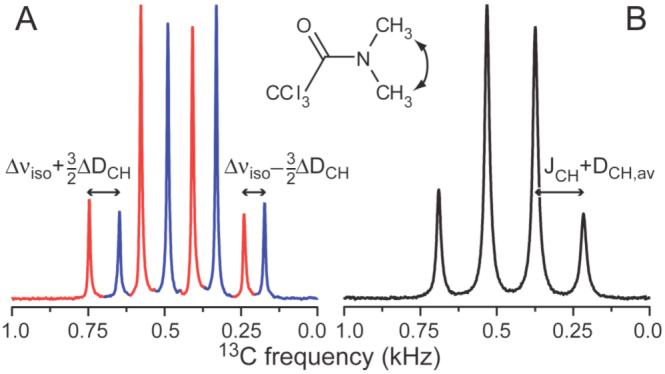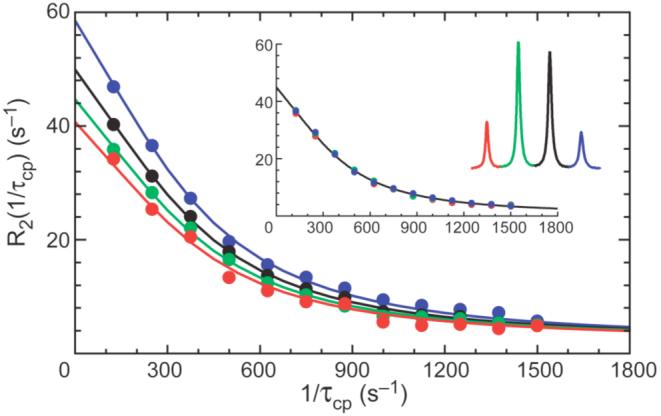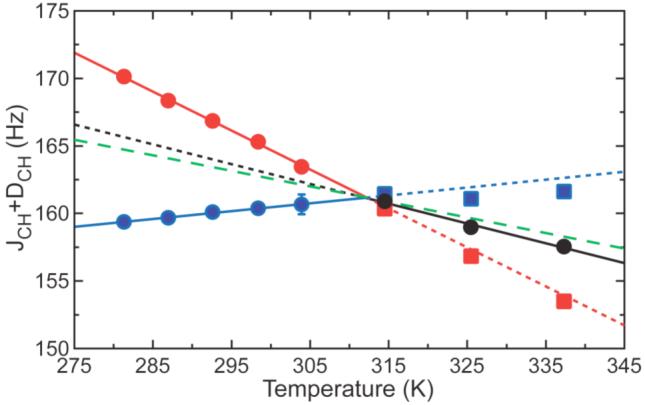Characterization of Chemical Exchange Using Residual Dipolar Coupling (original) (raw)
. Author manuscript; available in PMC: 2008 Nov 7.
Published in final edited form as: J Am Chem Soc. 2007 Oct 12;129(44):13396–13397. doi: 10.1021/ja0761636
Abstract
NMR lineshape analysis and relaxation dispersion measurements for N,N-dimethyltrichloroacetamide (DMTCA) weakly aligned using poly-γ-benzyl-L-glutamate, which forms a lyotropic nematic phase when dissolved in chloroform, were used to characterize chemical exchange kinetics for the rotation around the C-N amide bond. At low temperatures (<312 K), slow-exchange 1H-coupled 13C NMR spectra show two resolved 13C methyl quartets with different residual dipolar coupling constants (RDCs). At high temperatures (>312 K), a single population-averaged 13C methyl quartet is observed; in this regime, the differences in RDCs contribute to differential linebroadening of the quartet components. Self-consistent measurements of the difference in RDCs are obtained both from lineshape and relaxation dispersion techniques. The results show that NMR spectroscopy of weakly aligned molecules allow complete characterization of chemical exchange processes using RDCs, even if exchange broadening is absent in isotropic samples.
Chemical kinetic processes contribute to NMR transverse relaxation via temporal modulation of eigenfrequencies of nuclear spin states1. This relaxation mechanism is referred to as chemical or conformational exchange. Methods for quantification of chemical exchange arising from variation in isotropic chemical shifts2,3 have enabled powerful applications to functional dynamics of proteins and other biological macromolecules4,5. However, such methods have three drawbacks: (i) nuclei with differences in isotropic chemical shifts Δνiso ∼ 0 for exchanging states cannot be detected6,7, (ii) isotropic shifts for particular nuclei can be indirectly affected by motions of remote moieties8,9, and (iii) Δνiso is not a direct structural constraint and must be interpreted using database analysis or theoretical modeling9,10.
The present work demonstrates that anisotropic spin interactions, such as residual dipolar couplings (RDCs), in weakly aligned molecules can be used to detect and quantify chemical exchange processes. These interactions contribute to chemical exchange even if Δνiso = 0, are modulated only by motions of the affected nuclei, and provide direct orientational constraints on molecular structure. RDCs, generated using liquid crystalline media or other means, have been extensively used for structural and dynamical studies of small molecules11 and proteins12,13. 1H-1H RDCs and 2H quadrupolar coupling constants also have been used to characterize chemical exchange in small molecules dissolved in thermotropic and lyotropic liquid crystalline phases14-18. The complexity of strongly coupled 1H spectra and the requirement for selective 2H labels limit applications of these methods to fairly small systems. Heteronuclear 1H-13C RDCs are devoid of these limitations and are the primary focus of this work.
The small molecule N,N-dimethyltrichloroacetamide (DMTCA) was used as a model system for three reasons: (i) chemical exchange kinetics in isotropic solution are well characterized19,20, (ii) the transition from slow to fast chemical exchange occurs within an accessible temperature range, and (iii) the chemical structure and hence molecular alignment tensor remain unchanged by the kinetic exchange process. Weakly aligned samples of natural abundance and [13C2-methyl] DMTCA were prepared using poly-γ-benzyl-L-glutamate (PBLG), which forms a lyotropic nematic phase when dissolved in chloroform.
At low temperature, rotation around the amide partial double-bond is slow and the methyl groups occupying _cis_- and _trans_-positions relative to the carbonyl oxygen resonate at different frequencies. A coupled 125 MHz 13C NMR spectrum of weakly aligned DMTCA shows two resolved quartets with different apparent multiplet splittings resulting from different 1H-13C RDCs for the downfield (DCH,down) and upfield (DCH,up) methyl groups. (Figure 1A). The frequency differences between pairs of corresponding quartet components are, starting with the most downfield quartet components: Δνiso+1.5ΔDCH, Δνiso+0.5ΔDCH, Δνiso-0.5ΔDCH, and Δνiso-1.5ΔDCH, where ΔDCH =DCH,down-DCH,up. A slight asymmetry in quartet intensities is caused by non-negligible inter-methyl 1H-1H RDCs (Figure S4), and not by slow conformational dynamics or temperature gradients in the NMR sample (Figure S5). In an isotropic sample, ΔDCH = 0 and the frequency differences are all equal to Δνiso, confirming that differences between JCH scalar coupling constants are negligible.
Figure 1.

Methyl region of the slow (A) and fast (B) exchange 13C spectra of a weakly aligned [13C2-methyl] DMTCA sample, collected at 281.3 K and 325.5 K, respectively. JCH is the 13C-1H scalar-coupling constant, and DCH,av is the motionally averaged 13C-1H RDC. The difference between downfield (red) and upfield (blue) methyl 1H-13C RDCs, ΔDCH, contributes to the frequency differences between the equivalent quartet components in the slow exchange regime (A), and causes differential line-broadening of the quartet components in the fast exchange regime (B).
At high temperature, rotation around the amide bond is fast and a coupled 13C NMR spectrum of weakly aligned DMTCA displays one quartet with population-averaged resonance frequencies (Figure 1B). The contribution of ΔDCH to the frequency differences between quartet components results in differential broadening manifested in the overall asymmetry of the quartet. Control simulations and experiments eliminate temperature gradients, 1H-1H inter-methyl RDCs, and relaxation interference as the origins of this asymmetry (Figures S4(D) and S5).
Linewidths of the quartet components for DMTCA at three temperatures in the fast-exchange regime (Figure S3) were used to calculate ΔDCH = kΔνFWHH/|n|πΔνiso, in which k is the kinetic rate constant, site populations are set to 0.5, ΔνFWHH is the difference in linewidths for outer (inner) quartet components, and |n| = 3 (1) for outer (inner) lines. Values of ΔDCH obtained from inner and outer quartet components are in excellent agreement (Figure S6).
To corroborate the lineshape analysis, 13C-detected relaxation dispersion experiments were performed for aligned and isotropic DMTCA samples at 325.5 K using a constant-time Carr-Purcell-Meiboom-Gill (CPMG) relaxation period22 incorporating a central S3CT element23,24 to refocus effects of cross-relaxation. Dispersion curves for quartet components in the aligned sample have the same characteristic decay constant but different amplitudes (Figure 2). Frequency differences obtained from fitting the experimental data with the Carver-Richards equation21 were used to calculate ΔDCH = -4.7 ± 0.2 and -4.2 ± 0.4 Hz from outer and inner quartet components, in excellent agreement with the results of the lineshape analysis at 325.5 K, -4.2 and -4.3 Hz. Identical relaxation dispersion curves were observed for quartet components in the isotropic sample (Figure 2, inset). Parameters for the chemical exchange process are given in Table S2.
Figure 2.

CPMG relaxation dispersion curves for individual quartet components collected using the aligned and (inset) isotropic DMTCA samples at 325.5 K. The delay between 180° pulses in the CPMG sequence is τcp. Fits shown with solid lines were generated using the Carver-Richards equation21. Differences in the dispersion amplitudes (y-intercepts) for the quartet components arise for ΔDCH ≠ 0. Fitting procedures and data analysis are provided in the Supporting Information.
The 13C-1H RDCs for DMTCA obtained from slow- and fast-exchange spectra are consistent and show linear behavior for both upfield and downfield methyl quartets over the temperature range from 281 to 337 K (Figure 3). At temperatures >312 K, ΔDCH becomes negative, in agreement with Figures 1B and 2, where the most downfield resonance has the smallest linewidth and relaxation dispersion amplitude, respectively.
Figure 3.

Temperature dependence of JCH+DCH for downfield (red), upfield (blue), and motionally averaged (black) methyl 13C quartets in DMTCA. Experimentally measured values are shown as circles, corresponding linear fits with solid lines, and extrapolated linear fits with dotted lines. The green dashed line is the average of the linear fits for the upfield and downfield quartets in slow exchange. Squares represent data obtained from ΔDCH and DCH,av under fast exchange conditions.
In conclusion, RDCs can be used to fully characterize conformational exchange processes for weakly aligned molecules, even if Δνiso approaches zero in isotropic solution. The approaches presented above are not limited to 1H-13C RDCs and are equally valid for any weakly coupled spin multiplet. These methods also can be applied to biological macromolecules using multidimensional NMR techniques already established for isotropic measurements2,3,25. However, multiple 1H-1H couplings in macromolecules significantly impede 1H spectral resolution, especially if high degrees of alignment are needed to amplify RDC differences between chemical states. Deuteration26 in combination with 1H homonuclear decoupling27 may be necessary for 1H-detected experiments or direct 13C detection28 may be advantageous. Finally, if chemical exchange parameters already have been obtained using an isotropic sample, a single-field relaxation dispersion or lineshape experiment on an aligned sample suffices to obtain RDCs for use as orientational constraints for structural characterization of exchanging chemical states.
Supplementary Material
1si20070917_03
Acknowledgement
This work was supported by The Swedish Research Council (M. A.), The Royal Physiographic Society in Lund (U. B.), and NIH grants DK07328 (T. I. I.), and GM59273 (A.G.P.). We thank Mark Rance (University of Cincinnati) for helpful discussions and Bruker BioSpin Corp. for loan of a direct-detect broadband NMR probe.
References
- 1.Cavanagh J, Fairbrother WJ, Palmer AG, Rance M, Skelton NJ. Protein NMR Spectroscopy: Principles and Practice. Academic Press; Amsterdam: 2007. pp. 1–885. [Google Scholar]
- 2.Mittermaier A, Kay LE. Science. 2006;312:224–228. doi: 10.1126/science.1124964. [DOI] [PubMed] [Google Scholar]
- 3.Palmer AG, Massi F. Chem. Rev. 2006;106:1700–1719. doi: 10.1021/cr0404287. [DOI] [PubMed] [Google Scholar]
- 4.Kern D, Zuiderweg ERP. Curr. Opin. Struct. Biol. 2003;13:748–757. doi: 10.1016/j.sbi.2003.10.008. [DOI] [PubMed] [Google Scholar]
- 5.Palmer AG, Grey MJ, Wang CY. Methods Enzymol. 2005;394:430–465. doi: 10.1016/S0076-6879(05)94018-4. [DOI] [PubMed] [Google Scholar]
- 6.Grey MJ, Tang Y, Alexov E, McKnight CJ, Raleigh DP, Palmer AG. J. Mol. Biol. 2006;355:1078–1094. doi: 10.1016/j.jmb.2005.11.001. [DOI] [PubMed] [Google Scholar]
- 7.Massi F, Wang C, Palmer AG. Biochemistry. 2006;45:10787–10794. doi: 10.1021/bi060764c. [DOI] [PubMed] [Google Scholar]
- 8.Wang L, Pang Y, Holder T, Brender JR, Kurochkin AV, Zuiderweg ER. Proc. Natl. Acad. Sci. U.S.A. 2001;98:7684–7689. doi: 10.1073/pnas.121069998. [DOI] [PMC free article] [PubMed] [Google Scholar]
- 9.Grey MJ, Wang CY, Palmer AG. J. Am. Chem. Soc. 2003;125:14324–14335. doi: 10.1021/ja0367389. [DOI] [PubMed] [Google Scholar]
- 10.Xu XP, Case DA. Biopolymers. 2002;65:408–423. doi: 10.1002/bip.10276. [DOI] [PubMed] [Google Scholar]
- 11.Yan JL, Zartler ER. Magn. Reson. Chem. 2005;43:53–64. doi: 10.1002/mrc.1505. [DOI] [PubMed] [Google Scholar]
- 12.Bax A, Grishaev A. Curr. Opin. Struct. Biol. 2005;15:563–570. doi: 10.1016/j.sbi.2005.08.006. [DOI] [PubMed] [Google Scholar]
- 13.Tolman JR, Ruan K. Chem. Rev. 2006;106:1720–1736. doi: 10.1021/cr040429z. [DOI] [PubMed] [Google Scholar]
- 14.Boeffel C, Luz Z, Poupko R, Zimmermann H. J. Am. Chem. Soc. 1990;112:7158–7163. [Google Scholar]
- 15.Lafon O, Lesot P, Fan CA, Kagan HB. Chem. Eur. J. 2007;13:3772–3786. doi: 10.1002/chem.200601284. [DOI] [PubMed] [Google Scholar]
- 16.Luz Z. In: Nuclear Magnetic Resonance of Liquid Crystals. Emsley JW, editor. Vol. 141. D. Reidel Publishing Company; Dordrecht, Holland: 1983. pp. 315–340. [Google Scholar]
- 17.Ternieden S, Muller D, Muller K. Liq. Cryst. 1999;26:759–769. [Google Scholar]
- 18.Ternieden S, Zauser D, Muller K. Liq. Cryst. 2000;27:1171–1182. [Google Scholar]
- 19.Dimitrov VS, Ladd JA. Magn. Reson. Chem. 1985;23:529–532. [Google Scholar]
- 20.Gansow OA, Killough J, Burke AR. J. Am. Chem. Soc. 1971;93:4297–4298. [Google Scholar]
- 21.Carver JP, Richards RE. J. Magn. Reson. 1972;6:89–105. [Google Scholar]
- 22.Skrynnikov NR, Mulder FAA, Hon B, Dahlquist FW, Kay LE. J. Am. Chem. Soc. 2001;123:4556–4566. doi: 10.1021/ja004179p. [DOI] [PubMed] [Google Scholar]
- 23.Sørensen MD, Meissner A, Sørensen OW. J. Biomol. NMR. 1997;10:181–186. [Google Scholar]
- 24.Loria JP, Rance M, Palmer AG. J. Biomol. NMR. 1999;15:151–155. doi: 10.1023/a:1008355631073. [DOI] [PubMed] [Google Scholar]
- 25.Liu WD, Zheng Y, Cistola DP, Yang DW. J. Biomol. NMR. 2003;27:351–364. doi: 10.1023/a:1025884922203. [DOI] [PubMed] [Google Scholar]
- 26.Tugarinov V, Kanelis V, Kay LE. Nat. Protoc. 2007;1:749–754. doi: 10.1038/nprot.2006.101. [DOI] [PubMed] [Google Scholar]
- 27.Farjon J, Bermel W, Griesinger C. J. Magn. Reson. 2006;180:72–82. doi: 10.1016/j.jmr.2006.01.006. [DOI] [PubMed] [Google Scholar]
- 28.Balayssac S, Bertini I, Luchinat C, Parigi G, Piccioli M. J. Am. Chem. Soc. 2006;128:15042–15043. doi: 10.1021/ja0645436. [DOI] [PubMed] [Google Scholar]
Associated Data
This section collects any data citations, data availability statements, or supplementary materials included in this article.
Supplementary Materials
1si20070917_03